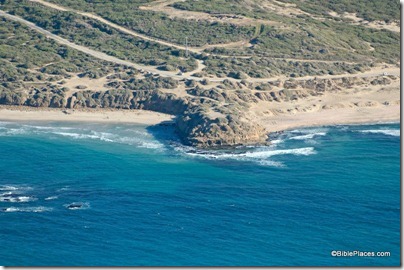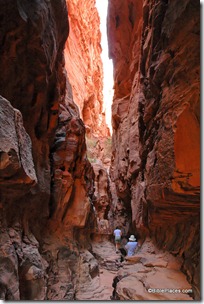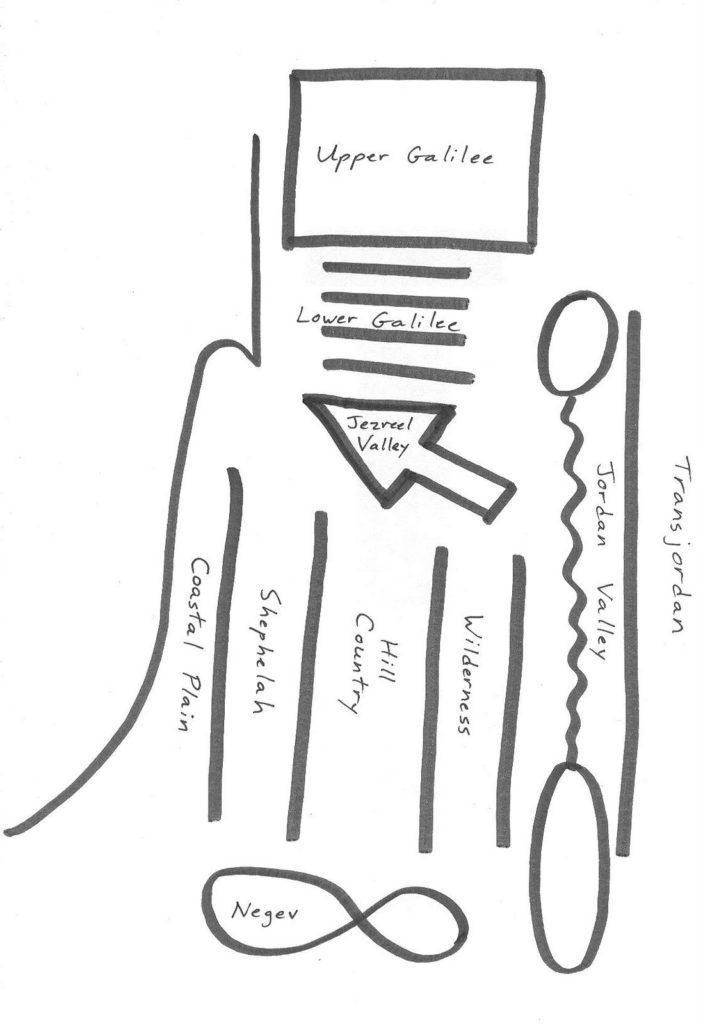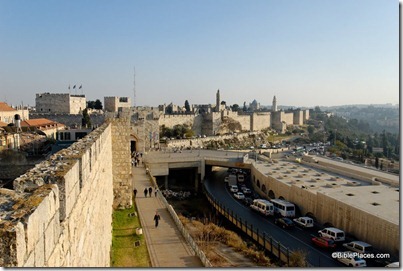A 600-lb metal anchor from the Byzantine period has been discovered off the coast south of Tel Aviv. The find led investigators to two others in the area. Photos are available from the IAA in a zip file. The Sound the Shofar exhibition opened last week in Jerusalem with more than 140 of the horns on display at the Bible Lands Museum. The story includes a two-minute video. The Jerusalem Post has more information about Google Street View in Jerusalem, Tel Aviv, and Haifa. Wayne Stiles takes readers on a visit to Shiloh, the longtime home of the tabernacle. The Archaeology of Libya is discussed in this week’s radio program at the Book and the Spade. (Here’s the direct link to the mp3 file). ATS Pro Terra Sancta has plans to renovate “the Holy Place of Sebastia.” I certainly support improving the conditions at the ancient city of Samaria, though it strikes me as odd to consider as holy the place where Ahab built a temple for Baal worship and Herod built another for the worship of the Roman emperor. An inscription in Aramaic and Greek on a stone lintel has been discovered in the area of ancient Sepphoris. The report is in Hebrew and includes a photograph. A Roman-era style bathhouse was constructed in the middle of a Early Islamic period fortress, say archaeologists excavating at Yavneh-Yam on Israel’s coast. HT: Joseph Lauer, Jack Sasson  Yavneh-Yam
Yavneh-Yam
What do you do after you’ve learned the historical geography of Israel? Recognize that the other half of the biblical story is on the east side of the Jordan River and plan to learn that.
The best way I know how to do that is through the Historical Geography of the Bible II course offered by the University of the Holy Land. I’ve participated in this study trip taught by Dr. Ginger Caessens and I highly recommend it. You simply cannot find another trip where you will learn and see more about biblical history in Jordan.
The class runs from July 2 to 16, 2012, and the cost is $2200 for full board, double occupancy (single supplement is $376). This includes two hours of credit but does not include airfare to Tel Aviv or transport from the airport to Jerusalem.
ITINERARY FOR HISTORICAL GEOGRAPHY OF THE BIBLE II (JORDAN):
Monday, July 2, Transfer from Israel to Jordan via Allenby Bridge; traditional baptismal site (Bethany-Beyond-Jordan?). Overnight in Amman. (Special arrangements can be made for those who
wish to join the group in Jordan rather than in Israel.)
Tuesday, July 3, Lectures. Overnight in Amman.
Wednesday, July 4, The Land of Ammon Field Trip: Amman Citadel (Rabbath-Ammon) and National Museum; remains of Philadelphia (Theater, Odeon); Rujm al-Malfouf (Ammonite tower);
Tall al-`Umayri; Kh. es-Sar; Iraq al-`Amir. Overnight in Amman.
Thursday, July 5, Upper Gilead Field Trip: Tall adh-Damiyya/ ancient Adam (view from road); Tulul adh-Dhahab (Mahanaim?); Tall Dayr `Alla (Penuel?); Ajlun Castle; Mar Elias, Listeb, and Umm al-Hedamus (Tishbeh?, home of Elijah). Overnight in Olive Branch Hotel near Jerash.
Friday, July 6, Lower Gilead Field Trip: view of Tall al-Maqlub (Jabesh-gilead?) from the village of Judeita; Tabaqat Fahel (Pella); Umm Qeiss (Gadara); Beit Ras (Capitolias); Tall ar-Rumeith (Ramothgilead?). Overnight in Olive Branch Hotel near Jerash.
Saturday, July 7, Jerash (Gerasa). Overnight in Amman.
Sunday, July 8, Free day. Overnight in Amman.
Monday, July 9, Quiz and Lectures. Overnight in Amman.
Tuesday, July 10, Medeba Plateau Field Trip: Tall Hisban (Heshbon); Kh. al-Mukhayyat (ancient village of Nebo); Mt. Nebo; Madaba Mosaic Map; Kh. `Attarus (Ataroth); Mukhawir (Machaerus);
Tall Araʼir (Aroer); Tall Dhiban (Dibon); W. Mujib/Arnon River Gorge. Overnight in Kerak.
Wednesday, July 11, Moab and Edom Field Trip: Kerak Castle; Sela (climb); Buseira (Bozra); view of W. Danna; `Udruh (Roman Fort). Overnight in Wadi Musa.
Thursday, July 12, Little Petra (Siq al-Barid); Petra. Overnight in Wadi Musa.
Friday, July 13, Caravan Routes East and South of Petra: Humayma (ancient caravan stop); Wadi Ram (2-hour jeep ride  followed by traditional meal in Bedouin tent); Wadi Yitm. Overnight in Aqaba.
followed by traditional meal in Bedouin tent); Wadi Yitm. Overnight in Aqaba.
Saturday, July 14, Wadi Arabah Field Trip: ancient Copper Mines at Feinan (Punon?); Kh. en-Nahash; Sanctuary of St. Lot/Deir `Ain Abata; Bab adh-Dhra (view from road); Hot springs of Kallirhoe. Overnight in Madaba.
Sunday, July 15, Exam. Overnight in Madaba.
Monday, July 16, Return to Jerusalem; program ends.
- Tagged Jordan, Opportunities
If you are around and about Jerusalem and want to be immortalized in Google Street View, you might spend more time walking on the sidewalk in the coming days. From Janglo:
If you spend your days in Jerusalem, you might want to try spending as much of them outdoors as possible. That is, if you want to have a chance at ending up in Google Street View maps of Jerusalem. Google recently received permission to start imaging cities in Israel and including them in the street view maps. This afternoon they are firing their opening shots, having decided to begin their imaging in Jerusalem. They will be holding a ceremony in Jerusalem with Mayor Nir Barkat to kick off the process.. So, if you hang out in the great outdoors of Jerusalem enough in the immediately near future, you might just end up as a pedestrian in Google Street View maps.
The following notice was sent out to the Archeologylist at Southern University.
The exciting new archaeology series “Astonishing Discoveries” with Dr. Michael G. Hasel and Dr. Ron Clouzet will be downlinked live to hundreds of churches across the United States this coming week, September 14-18, at 7:30 p.m. EDT. It can also be seen on Hope Church Channel (http://www.hopetv.org/watch-now/watch-live-online/hope-church-channel/). See the attached schedule for programing. Invite your friends and participate for this major event!
The schedule, available in pdf here, lists the following shows:
Wed., Sept 14, 7:30 pm: Egyptian Wonders That Stunned the World
Thurs., Sept 15, 7:30 pm: Babylon, Sumer, and the Quest for Power
Fri., Sept 16, 7:30 pm: The Greatest Discoveries in the Land of Israel
Sat., Sept 17, 7:30 pm: The Spade and the Historical Jesus
Sun., Sept 18, 7:30 pm: Living Rocks from the Apocalypse
- Tagged Opportunities
The Jordan Lead Codices are fake, fake, fake. This video by Tom Verenna explains why.
JPost’s weekly column “Off the Beaten Track” is inaptly titled this week, but you still may enjoy the tour of Jaffa Gate and the Old City wall running south to Mount Zion.
Less satisfying is Yoni Cohen’s story describing the trails at Ramat Hanadiv (but little about the site!).
In “Archaeology in Israel Update—August 2011,” Stephen Gabriel Rosenberg writes about the “Boundary stone found in Lower Galilee, “Ancient Shechem to be opened to the Public,” “Jerusalem sewage ditch yields up more treasures,” “Phaesalis [sic] City Unvovered” [sic], and “Bathhouse Hercules in the Jezre’el Valley.”
“Seventy-five archaeological missions will resume excavation projects in Egypt as of Monday.”
It is being reported that Egypt will require visitors to acquire a visa before arriving. If it happens, it will no doubt reduce the number of tourists.
Gertrude Bell is remembered in the Jerusalem Post 85 years after her death.
USA Today has named the Glo Bible the #1 coolest book app for the fall. They are impressed with the “700 images of religious art, 2,300 full-color photos and 500 virtual tours of Biblical sites, 140 interactive maps and study tools.” An Android version is coming for all of those with iPhobia.
HT: Joseph Lauer, Jack Sasson
- Tagged Egypt, Jerusalem, Pseudo-Archaeology, Weekend Roundup
Last week I lamented that Joe Yudin’s tour of Jerusalem tombs would have benefited from some photos. Shmuel Browns has fulfilled that need with pictures and a map.
In the heart of Mea Shearim in Jerusalem, the Ultra-Orthodox have held the first conference on “Torah archaeology.” This is a welcome change for a group known for its vocal, and sometimes violent, opposition to archaeology.
The editors at Bible and Interpretation reflect on how they have scooped Biblical Archaeology Review multiple times this year.
A couple of stories about the 12th Annual City of David Archaeology Conference were widely circulated this week. I held off posting, preferring a story that described what happened rather than predicted what might happen. What “newest research and discoveries” was revealed? Did the conference “overturn popular theories”? So far I have seen no reports.
Seth Rodriquez has written and illustrated a simple way to teach people how to “draw the map” of Israel with its major geographic features.

- Tagged Jerusalem, Weekend Roundup
The BiblePlaces Blog provides updates and analysis of the latest in biblical archaeology, history, and geography. Unless otherwise noted, the posts are written by Todd Bolen, PhD, Professor of Biblical Studies at The Master’s University.
As an Amazon Associate we earn from qualifying purchases. In any case, we will provide honest advice.

